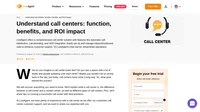What is dual-tone multi-frequency signaling?
Dual-tone multi-frequency signaling (also known as DTMF) is a telecommunications technology for transferring information between telephone devices and telephone switching centers by means of in-band audio tones sent over voice frequencies. Simply put, DTMF signaling translates audible tones from pressing keys on telephone keypads into readable information that telecom companies use to process incoming phone calls.
A network of telecommunication companies called The Bell System introduced DTMF in 1963. It subsequently became trademarked as ‘Touch-Tone’ for use in push-button telephones. It was primarily used for telephone signaling to and from the local exchange, though DTMF made long-distance calling possible and today it is widely used in telecommunications and call centers.
As the name suggests, dual-tone multi-frequency signaling uses a combination of eight audio frequencies transmitted in pairs to represent sixteen signals, represented by the ten numerical digits, the letters A to D, and the symbols # and *. The keys A, B, C, D, ended up being dropped from consumer desk phone sets and are mainly used in radio equipment and internal network controls of telephone companies.
What is dual-tone multi-frequency signaling used for?
DTMF works by assigning eight different audio frequencies to the rows and columns of the keypad. Each dial row is defined by a low tone frequency and each column by a high tone frequency. When a key corresponding to a number or symbol is pressed, the phone generates a tone that simultaneously combines high-frequency and low-frequency signals. This unique signal pair is then transmitted to the local exchange and decoded to determine which number was dialed and how to route the call appropriately. DTMF can be transmitted over active telephone lines, the internet, and a radio.
The primary function of dual-tone multi-frequency signaling is identifying the dialed number and process information from customers. DTMF is employed in various industries ranging from telecommunications (inbound/ outbound call centers) and financial institutions (banks and credit card companies) to insurance and healthcare organizations. In call centers, DTMF signaling is mainly used to process user requests, obtain identification information, and route phone calls based on the keypad entries made by the caller. In addition, the DTMF technology is used in conjunction with IVR (Interactive voice response) and ACD (Automated call distribution) systems to navigate in-call menus and gather sensitive customer data.
Call center features for better customer experience
Try out all LiveAgent's features today.
Using DTMF signaling has a number of advantages, such as:
- Higher security
When it comes to obtaining user input, dual-tone multi-frequency signaling provides a higher level of security. It reassures callers that their sensitive data (like credit card information, social security numbers, etc.) are protected and safe from malicious intents. As the human ear cannot interpret DTMF tones, sensitive customer information remains isolated from agents and call recording systems.
- Reduced probability of errors
With dual-tone multi-frequency technology, there is only one point of data entry. Without DTMF, the caller would have to read out the data as the agent would have to type it into their desktop application, increasing the possibility of errors on both ends.
- Improved call center metrics
Obtaining user input via dual-tone multi-frequency signaling can also improve several inbound call center metrics, such as Average Handling Time (AHT). Since agents don’t need to repeat user details back to the caller to confirm the accuracy of the input, the average duration of an interaction with a caller is reduced. In addition, the increased security provided by DTMF can contribute to improved customer satisfaction levels.
What is the difference between pulse dialing and DTMF dialing?
Pulse dialing and dual-tone multi-frequency (DTMF) dialing are the two systems used in telephone signaling to identify the telephone number that a caller dials. In pulse dialing, pulses are generated by rapidly connecting and disconnecting the telephone connection. Pulse dialing indicates each digit in the phone number by a series of clicks that corresponds only to that digit. Thus 1 is represented by one click, 2 by two clicks, and so on. The numbers are dialed with a short gap between pulses in order to identify one digit from the next. Pulse dialing technology is no longer actively used.
DTMF dialing uses different tones to indicate a different number. Thus, instead of sending multiple signals for each digit, it would only need to send one for each. Before the introduction of DTMF dialing, telephone communication networks depended on pulse dialing. However, it had the disadvantage that it was limited to the local exchange connections and required an intermediate operator for connecting long-distance calls. Since the launch of DTMF, touch-tone dialing became the primary dialing method that gradually replaced pulse dialing (along with its associated rotary dial telephones). Despite this, most telephone systems that use tone dialing can also recognize and work with pulse dialing.
Efficient call center software just one click away
Start your 30-day free trial, no credit card required.
Frequently Asked Questions
What is dual-tone multi-frequency signaling?
Dual-tone multi-frequency signaling (DTMF), also called touch-tone, is a system used for telecommunication signaling over an active telephone line in the voice frequency band between communication devices. Whenever a number is dialed, the DTMF is decoded by the local exchange in order to route the call. DTMF systems use eight different frequency signals transmitted in pairs (one high frequency and one low frequency) to represent 16 different numbers, letters, and symbols.
What is dual-tone multi-frequency signaling used for?
Today, the DTMF signaling technology is widely used in the call center industry to route incoming calls using the keypad entries made by the caller and process user requests. When paired with Interactive Voice Response (IVR), DTMF provides automated self-service menu selection and gathers sensitive customer data. As a result, it has a number of advantages, such as the reduced probability of errors, higher security, and improved metrics (reduced average call handling time).
What is the difference between pulse dialing and DTMF dialing?
Pulse dialing and dual-tone multi-frequency dialing (tone dialing) are the two methods used in telephone signaling to recognize the dialed number. Pulse dialing uses different signal pulses to indicate the phone number dialed by a caller, while DTMF dialing uses specific tones to indicate the number. Since the introduction of DTMF, pulse dialing has lost its significance. Tone dialing has now become the standard for telephone companies worldwide.
After learning about dual-tone multi-frequency, you might be curious to dive deeper into how it works. Check out the section on dual-tone multi-frequency signaling to understand the differences between pulse dialing and DTMF dialing. If you're interested in how DTMF is used in everyday applications, the article on what is dual-tone multi-frequency signaling used for provides great insights. Lastly, if you have any lingering questions, our frequently asked questions section might have the answers you're looking for.
Understand call centers: function, benefits, and ROI impact
Discover the ins and outs of call centers, their benefits, common challenges, best practices, and future trends that can shape the industry.
Understand call centers: function, benefits, and ROI impact
Streamline customer support with LiveAgent's call center. Easy setup, advanced features, free trial & budget-friendly plans. Try now!"

 Български
Български  Čeština
Čeština  Dansk
Dansk  Deutsch
Deutsch  Eesti
Eesti  Español
Español  Français
Français  Ελληνικα
Ελληνικα  Hrvatski
Hrvatski  Italiano
Italiano  Latviešu
Latviešu  Lietuviškai
Lietuviškai  Magyar
Magyar  Nederlands
Nederlands  Norsk bokmål
Norsk bokmål  Polski
Polski  Română
Română  Русский
Русский  Slovenčina
Slovenčina  Slovenščina
Slovenščina  简体中文
简体中文  Tagalog
Tagalog  Tiếng Việt
Tiếng Việt  العربية
العربية  Português
Português 




